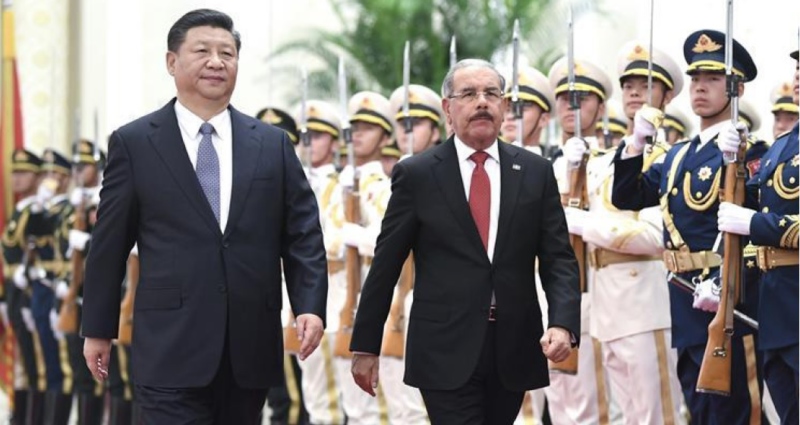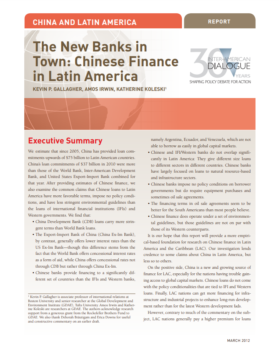The Politics Of Disaster Relief
After a 7.0 magnitude earthquake struck Haiti, the aftershock reached China in ways that few anticipated.The earthquake forced Chinese leaders to navigate the tricky politics of disaster relief.
A Daily Publication of The Dialogue
The Dominican Republic’s president, Danilo Medina, in late March met with Chinese Vice Premier Hu Chunhua in Santo Domingo, where they agreed on new economic cooperation accords and followed up on agreements that the two countries made last year. The visit was among the first high-level meetings since the Caribbean nation severed ties a year ago with Taiwan in favor of establishing them with China. What are the most important avenues for cooperation between the Dominican Republic and China? How much have ties with China paid off for the Dominican Republic in the past year? To what extent should the Dominican Republic and other countries in the region be wary of getting too close with China, as the United States has warned?
G. Philip Hughes, senior director at the White House Writers Group and former ambassador to Barbados and the Eastern Caribbean: “Combine China’s and the Dominican Republic’s common challenge of sustaining the high economic growth rates to which they’ve become accustomed, their parallel ambitions for greater economic and political influence, and China’s permanent diplomacy to extinguish recognition of Taiwan by offering a better deal to nations that switch recognition, and the economic rapprochement between the Dominican Republic and China is no mystery. The first 10 months or so of the bilateral relationship have seen a flurry of grandiose promises and ambitions for trade, investment and tourism. But the Dominican Republic faces strong headwinds in placing its economic relationship with China on a new footing. For one thing, the country’s imports from China have far exceeded its exports to China. New, showy construction projects will come with Chinese companies—and their workers—entrenching, on the island forever, competing with local, firms and their local workers for big contracts., Fewer than imagined Chinese tourists will fly 8,000 miles and more to visit the Dominican Republic. Chinese concessional financing will come with strings attached—buy Chinese equipment—and ‘gifts’ of big, showy projects will come with reminders to be sure that the Dominican Republic votes China’s way on international issues, especially now that the Caribbean nation sits on the U.N. Security Council. President Medina’s government may find that this regular nudging drives wedges between the Dominican Republic and its traditional friends and largest trading partners, such as the United States, precisely as intended. If their approach is exploitative—without the necessary investment, local employment and domestic content—Chinese companies using the Dominican Republic to capitalize on DR-CAFTA access to the U.S. market could jeopardize the whole agreement. It’s not hard to imagine President Trump’s reaction. Amid all the hype in these early days, the Dominican Republic should be cautious. As Medina understandably reaches for means and options to sustain the Dominican Republic’s remarkable growth, he’ll want to avoid the classic economic trap of Caribbean economies: relying on dreams and promises in place of plans and achievements.”
Margaret Myers, director, and Ricardo Barrios, program associate, both in the Asia & Latin America program at the Inter-American Dialogue: “Like many other countries in the region, the Dominican Republic is mostly looking to China for help with infrastructure development. China is reported to have offered a package worth $3 billion in exchange for the Dominican Republic’s diplomatic recognition, $1.6 billion of which was designated for infrastructure projects. Already, the Caribbean nation has secured a $600 million loan from China’s Export-Import Bank to upgrade its power distribution systems, and President Medina has flagged additional projects for possible Chinese support, including the modernization of the Port of Arroyo Barril. In addition to infrastructure-related objectives, Dominicans are also hoping to grow and diversify trade with China through several new agreements, including a protocol on tobacco and related products. The Dominican Republic has already seen a slight increase in exports of raw materials, such as aluminum and nickel, to Chinese markets. The effects of the Dominican Republic’s new ties to China will be determined in very large part by the extent of Chinese engagement and the types of deals that Medina and his government sign with China. Growth in Dominican trade with China, including market access for a wider range of Dominican products, will no doubt boost economic growth. Chinese financial support for infrastructure can also be beneficial, but as we’ve seen in Latin America and the Caribbean and elsewhere in the world, it has occasional negative effects on countries’ economic well-being, quality of governance, regulatory affairs and the environment. The outcomes are already quite varied among recent converts. Costa Rica, which established ties with China in 2007, has since carried out only one major infrastructure project with Chinese assistance. Panama is working with China on a handful of projects, but without major infusions of Chinese state finance.”
Mary Fernández Rodríguez, founding partner at Headrick Rizik Álvarez & Fernández in Santo Domingo: “One of the most important avenues for cooperation between the two countries is in the energy sector. A year has already gone by since China and the Dominican Republic established diplomatic ties. Although both governments have signed 18 bilateral agreements aimed at promoting commercial, financial, tourist, aviation, immigration, educational, agricultural and sports cooperation, among others, as of now, these deals have not had a significant impact on the Dominican Republic. Exports have increased, but we still have a huge gap as compared to our imports from China. Although tourism increased by 33 percent as compared to 2017, the total amount is not significant. The Dominican Republic, as any other country, should be wary of entering debt traps, which we have seen happen in other countries. China has financed around 35 ports around the world. One of them, located in Hambantota, Sri Lanka, is now under Chinese control for 99 years after defaults in payments. This case is a typical example of the dangers of entering into agreements to offer assets in exchange for debt, which can happen when projects are not properly structured. Additionally, the potential increase of corruption, due to practices deviating from the Western rule of law, is something that should worry the Dominican Republic very much.”
The Latin America Advisor features Q&A with leaders in politics, economics, and finance every business day. The publication is available to members of the Dialogue’s Corporate Program and others by subscription.
After a 7.0 magnitude earthquake struck Haiti, the aftershock reached China in ways that few anticipated.The earthquake forced Chinese leaders to navigate the tricky politics of disaster relief.
Estimates of the volume, composition, and characteristics of Chinese lending to the region since 2005.
Dominican politics are vibrant yet patrimonial.
 Chinese President Xi Jinping (L) held talks in Beijing last November with Dominican Republic President Danilo Medina, who decided to reject longtime ally Taiwan in establishing relations with China. // Photo: Xinhua.
Chinese President Xi Jinping (L) held talks in Beijing last November with Dominican Republic President Danilo Medina, who decided to reject longtime ally Taiwan in establishing relations with China. // Photo: Xinhua.
